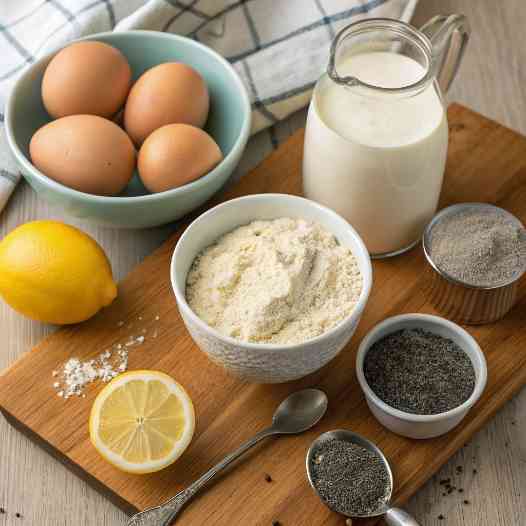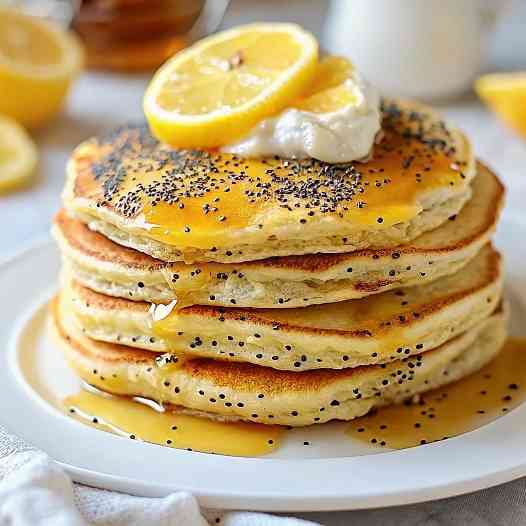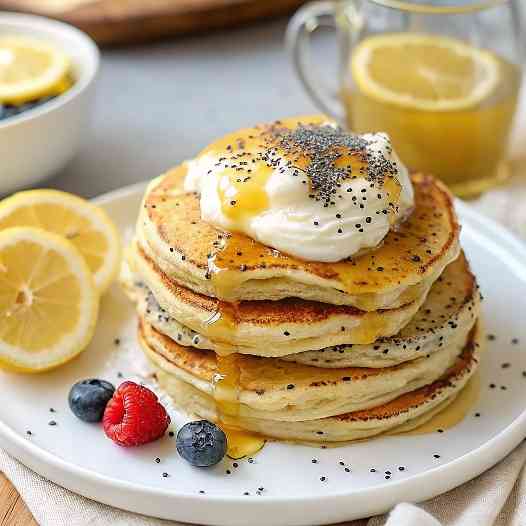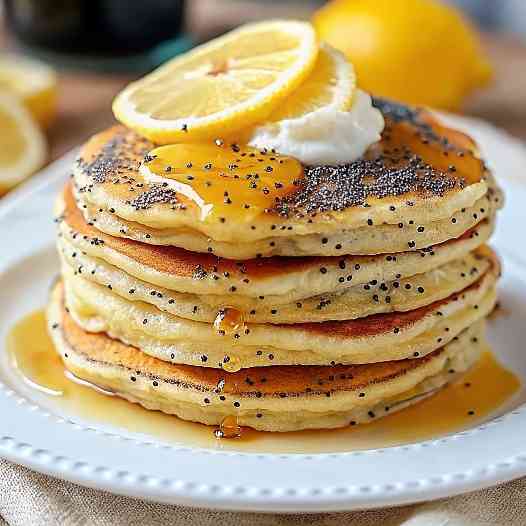Introduction
Lemon poppyseed protein pancakes combine tangy citrus flavor with the nutty crunch of poppy seeds and the muscle-repair benefits of added protein. This recipe offers a breakfast that’s not just delicious but also packed with fuel for your day. Whether you’re into meal prep, post-workout refuels, or weekend brunches, these pancakes hit the spot. In this article, you’ll find everything from ingredient tips to calorie counts, plus expert guidance on how to keep protein pancakes soft and satisfying. Get ready for a zesty, high-protein start to your morning.
Table of Contents
Why Lemon Poppyseed Protein Pancakes Are a Smart Breakfast Choice
The Power of Protein Pancakes vs. Regular Pancakes
Traditional pancakes are a breakfast favorite, but they’re often high in refined carbs and low in protein. That combo may spike blood sugar and leave you hungry again within an hour. On the other hand, lemon poppyseed protein pancakes offer a better balance of macronutrients. They help build and repair muscles, stabilize energy, and keep you full longer. Protein slows digestion, preventing crashes and cravings later in the day.
One major advantage of protein pancakes is their adaptability. You can include egg whites, Greek yogurt, or your favorite protein powder to boost protein content without sacrificing texture. Recipes like these Pumpkin Protein Pancakes show how adding natural protein sources can make a difference in flavor and satiety.
Protein pancakes also pair well with nutritious toppings. Instead of maple syrup, try plain yogurt with berries or almond butter for an even more balanced meal. These tweaks help reduce sugar while still delivering flavor. That’s a smart move, especially if you’re watching your energy levels throughout the day.
Need more weekday-friendly ideas? Our 10 Healthy Breakfast Toast Ideas for Kids and Moms is a helpful resource if you like variety without giving up on health.
Why Lemon and Poppy Seeds Make a Perfect Combo
There’s a reason lemon and poppy seeds are a classic match. The bright acidity of lemon lifts the batter’s flavor, while poppy seeds add a subtle nuttiness and satisfying crunch. The combination brings texture and balance to each bite of your pancakes.
Lemon also plays a functional role. The citric acid in lemon juice reacts with baking powder or baking soda, helping the pancakes rise and giving them a fluffier texture. It’s a natural solution that boosts both flavor and form.
Poppy seeds, though tiny, are nutrient-rich. They provide fiber, calcium, magnesium, and healthy fats. While not a major protein source, they contribute important nutrients that round out your breakfast. In lemon poppyseed protein pancakes, they work as both a garnish and a core ingredient.
When blended with a protein-rich batter, lemon zest enhances taste without added calories. It makes the dish feel fresh and light—a welcome change from overly sweet breakfast recipes. This combo satisfies flavor lovers and health-conscious eaters alike.
Key Ingredients for Lemon Poppyseed Protein Pancakes
Best Protein Powders for Pancakes
When making lemon poppyseed protein pancakes, not all protein powders behave the same. Some brands mix smoothly and create a light texture, while others may leave your batter thick and chalky. For this recipe, go for a whey isolate or a plant-based protein with a neutral or vanilla flavor.
Whey protein offers a fluffy result and blends easily. It also has a complete amino acid profile, which helps with post-workout recovery. If you’re dairy-free, try pea protein or a seed-based blend, but avoid hemp protein alone—it can overpower the lemon flavor and cause dense results.
Look for clean labels. Choose powders with no artificial sweeteners or added gums, as these can cause aftertastes or interfere with how the batter cooks. The Sweet Potato Bread recipe on our site is another great example of how to use nutrient-dense ingredients without compromise.
Test the scoop size. Most protein powders include a 30g scoop. One scoop per batch (usually 4–6 pancakes) keeps the balance right between flavor and texture. You want added protein, not rubbery pancakes.
For an extra burst of citrus flavor, some bakers add a scoop of lemon-flavored collagen peptides. It enhances both protein content and taste, although it’s optional. The idea is to keep the flavor fresh and bright, never bitter.
Why Fresh Lemon Zest and Juice Matter
Lemon is the star of lemon poppyseed protein pancakes, so using fresh ingredients makes all the difference. Bottled lemon juice lacks the natural oils and zest that give real lemons their signature brightness.
Fresh lemon zest adds powerful citrus oils that infuse the batter with aroma. Use a microplane grater and only zest the outer yellow layer, avoiding the bitter white pith underneath.
As for juice, use freshly squeezed lemon rather than bottled. It gives your pancakes an acidic kick that reacts with baking powder for a fluffier rise. Lemon juice also adds moisture, which is especially helpful when you’re using protein powder that tends to dry batters.

Want another lemon-based treat? Try our Lemon Blueberry Cheesecake for a satisfying dessert option using similar flavor principles.
Lastly, add lemon extract only if you love bold citrus. Just a few drops go a long way. Combined with zest and juice, it intensifies flavor without being overpowering.
How to Make Lemon Poppyseed Protein Pancakes
Print
Lemon Poppyseed Protein Pancakes
Fluffy, zesty, and protein-packed, these lemon poppyseed protein pancakes are a quick and healthy breakfast for any day of the week. Perfect for meal prep or post-workout fuel.
- Total Time: 15 minutes
- Yield: 2 servings (makes 4–6 pancakes) 1x
Ingredients
-
½ cup oat flour or almond flour
-
1 scoop (30g) protein powder (vanilla or unflavored)
-
1 tbsp poppy seeds
-
1 tsp baking powder
-
Pinch of salt
-
2 eggs or ¼ cup egg whites
-
½ cup almond milk or milk of choice
-
2 tbsp Greek yogurt or mashed banana
-
1 tbsp lemon juice
-
1 tsp lemon zest
-
½ tsp vanilla extract
-
Coconut oil or butter for greasing
Instructions
-
In a large bowl, whisk oat flour, protein powder, poppy seeds, baking powder, and salt.
-
In a separate bowl, beat the eggs, milk, Greek yogurt, lemon juice, lemon zest, and vanilla extract.
-
Pour wet ingredients into dry and stir gently until just combined. Let batter rest 3–5 minutes.
-
Heat a nonstick skillet over medium. Lightly grease with oil or butter.
-
Scoop ¼ cup batter per pancake. Cook for 2–3 minutes until bubbles form, then flip and cook 1–2 more minutes.

Batter for lemon poppyseed protein pancakes sizzling in a hot pan -
Serve warm with yogurt, berries, nut butter, or honey.
Notes
-
For vegan: Use flax egg, dairy-free milk, and plant-based yogurt.
-
For low-carb: Use almond flour and a sugar-free sweetener.
-
Batter thickens quickly due to protein powder; adjust with a splash of milk if needed.
-
Best enjoyed fresh but also great for meal prep and freezing.
- Prep Time: 5 minutes
- Cook Time: 10 minutes
- Category: Breakfast
- Method: Stovetop
- Cuisine: American
Nutrition
- Serving Size: 1 serving
- Calories: 305
- Sugar: 5g
- Sodium: 180mg
- Fat: 8g
- Saturated Fat: 2g
- Unsaturated Fat: 5g
- Trans Fat: 0g
- Carbohydrates: 25g
- Fiber: 4g
- Protein: 27g
- Cholesterol: 90mg
Keywords: lemon poppyseed protein pancakes, healthy protein pancakes, lemon breakfast pancakes
You’ll notice these pancakes cook a bit slower than traditional ones, just like recipes that require moisture balance, such as our How to Cook Soft Fluffy Jasmine Rice.
Common Pancake Mistakes to Avoid
Even with the right ingredients, protein pancakes can go wrong without the right techniques. Here are the top mistakes to avoid:
1. Overmixing the batter:
Overmixing forms gluten, which can make pancakes rubbery. Stir gently until just combined.
2. Skipping resting time:
Resting the batter for 3–5 minutes lets the baking powder activate and helps hydrate the protein powder. It results in fluffier pancakes.
3. Cooking on too high heat:
High heat causes the outside to burn before the inside cooks. Stick with medium heat and be patient.
4. Adding too much protein powder:
Too much will make your pancakes dense and chalky. One scoop is enough for balance.
5. Using bottled lemon juice:
Fresh lemon juice gives a clean, vibrant taste. Bottled varieties are dull and sometimes bitter.
6. Ignoring pan quality:
Thin or uneven pans won’t distribute heat well, leading to uneven cooking. Use a heavy-bottomed skillet or a quality nonstick griddle.
Nutrition Facts of Lemon Poppyseed Protein Pancakes
How Many Calories Are in Lemon Poppy Seed Pancakes?
One of the most common questions about lemon poppyseed protein pancakes is their calorie count. It depends on the ingredients and portion size, but here’s a typical breakdown for one serving (3 medium pancakes) made with whey protein, oat flour, almond milk, Greek yogurt, and an egg:
| Nutrient | Amount |
|---|---|
| Calories | 290–320 |
| Protein | 25–30g |
| Carbohydrates | 20–28g |
| Fat | 6–9g |
| Fiber | 3–5g |
Compared to traditional pancakes that can top 400 calories with barely 6 grams of protein, these provide a leaner, more filling option. You get the boost of citrus flavor plus the satisfaction of a high-protein breakfast that doesn’t weigh you down.
If you’re tracking macros or managing weight, this recipe fits into most meal plans. You can even tweak ingredients to lower calories further, as seen in lightened-up meals like our Simple Ground Beef Recipe.
Macronutrients: Protein, Carbs, and Fats Explained
Let’s look at how lemon poppyseed protein pancakes stack up in terms of macronutrients:
Protein:
The key benefit of these pancakes is their high protein content. Whether you use whey, pea, or a plant-blend powder, you’ll get 25–30 grams of protein per serving, which supports muscle recovery and satiety. Greek yogurt and eggs also contribute to the total.
Carbs:
The carbs in these pancakes mainly come from oat flour, almond milk, and lemon juice. But because they’re paired with protein and fiber, they digest more slowly—keeping blood sugar stable. Total carbs usually range from 20–28g per serving.
Fats:
Most of the fat comes from egg yolks and a small amount of cooking oil. If you’re adding nut butter on top, that will raise the fat slightly. Total fat generally falls between 6–9g, with low saturated fat if you’re using healthy oils.
Fiber:
Thanks to oats, poppy seeds, and lemon zest, these pancakes contain up to 5 grams of fiber, which aids digestion and supports gut health. Fiber also improves satiety—something you’ll feel right away.
Like our Cheddar and Turkey Melt on Sourdough, these pancakes are a meal you can feel good about from both a taste and health perspective.
Customizing Your Lemon Poppyseed Protein Pancakes
Vegan and Dairy-Free Swaps
You don’t need eggs or dairy to enjoy lemon poppyseed protein pancakes. With a few smart substitutions, you can make this recipe fully plant-based without losing flavor or texture.
For the eggs:
Use a flax egg (1 tbsp ground flaxseed + 2.5 tbsp water) or mashed banana. These bind the batter well while adding moisture. Chia eggs also work, though they change the texture slightly.
For dairy milk or yogurt:
Replace dairy with unsweetened almond, oat, or coconut milk. For yogurt, try coconut-based yogurt or a thick cashew yogurt. These options maintain creaminess while keeping the pancakes moist.
For protein powder:
Choose a clean plant-based protein like pea, brown rice, or a blend. Stick to unflavored or vanilla, as some vegan powders can taste overly earthy. The right blend keeps your lemon poppyseed protein pancakes light, not dense.
Flavor-wise, fresh lemon juice and zest will still shine through. Vegan options won’t dull that signature citrus profile if you’re using high-quality plant ingredients.
Looking for more vegan treats? Our Vegan Banana Nut Blondies Recipe is a must-try for anyone craving chewy, egg-free desserts with protein.
Low-Carb and Gluten-Free Options
Low-carb and gluten-free eaters can still enjoy the refreshing taste of lemon poppyseed protein pancakes by tweaking the base ingredients.
For a low-carb version:
Swap oat flour for almond flour or coconut flour. Almond flour adds healthy fats and moisture. Coconut flour is drier and more absorbent, so reduce the quantity by half and add extra eggs or liquid.
To reduce sugar:
Use monk fruit or stevia as sweeteners if you’re cutting back on added sugars. These blend well with lemon without altering flavor.
For gluten-free eaters:
Use certified gluten-free oats or a gluten-free flour blend. Avoid blends with too many gums or starches—they can affect texture. Keep your batter thick, and test cook one pancake before finishing the batch.
To boost fiber and texture:
Add 1 tablespoon of psyllium husk or flax meal to improve structure, especially if using coconut flour. These natural binders help hold the batter together and improve consistency.
Our The Softest Gluten-Free Cinnamon Rolls show how creative ingredient swaps still produce soft, satisfying results—just like these pancakes.
Expert Tips for Fluffy, Moist Lemon Poppyseed Protein Pancakes
Why Your Protein Pancakes Might Turn Out Dry
It’s common to struggle with texture when making lemon poppyseed protein pancakes, especially if you’re new to using protein powder in baking. Protein powder absorbs more liquid than regular flour, which can lead to dry or rubbery pancakes if you’re not careful.
Here are the most common reasons your pancakes feel dry or dense:
1. Too much protein powder:
One scoop per batch is usually enough. Adding more doesn’t increase benefits—it just makes your batter thick and chewy.
2. Not enough moisture:
Since protein powders absorb liquid quickly, your batter needs a moisture boost. Add a splash of almond milk, Greek yogurt, or mashed banana to help balance it out.
3. Skipping acidic ingredients:
Lemon juice doesn’t just flavor the batter—it also reacts with baking powder to lighten texture. Leaving it out flattens your pancakes.
4. Overcooking:
Cooking too long or on high heat dries out pancakes fast. Stick to medium heat and flip as soon as you see bubbles and set edges.
5. Thin pans or poor heat distribution:
Thin pans create hot spots, which can burn pancakes. Use a nonstick griddle or thick skillet to keep things even.
Getting the moisture balance right is key. It’s the same principle used in ultra-soft bakes like our How to Make Soft and Fluffy Shokupan, where technique matters as much as ingredients.
How to Keep Pancakes Fluffy with Protein Powder
There are a few secrets to getting that light, cake-like texture in lemon poppyseed protein pancakes—even when you’re loading them up with extra protein.
Use baking powder generously:
This gives pancakes their lift. Don’t confuse it with baking soda, which requires more acid to activate and can turn batter bitter if misused.
Let your batter rest:
After mixing, wait at least 5 minutes before cooking. Resting allows the baking powder to activate and the oats (or flour) to hydrate, giving you fluffier results.
Choose whey isolate if possible:
Whey isolate creates the lightest texture among protein powders. Plant-based powders can work too, but test the texture as you go.
Add an egg for structure:
Even with yogurt or milk, a whole egg provides extra lift and elasticity. It helps the pancakes hold their shape and keeps them from falling flat.
Beat egg whites separately (optional):
For extra fluffiness, separate your eggs and whip the whites until soft peaks form. Fold them into your batter gently. This is an advanced trick, but it’s a game-changer.
Looking for a vibrant drink to go with your pancakes? Try our Butterfly Pea Flower Tea Recipe—it’s colorful, refreshing, and full of antioxidants.
Serving Ideas and Add-Ons for Lemon Poppyseed Protein Pancakes
Best Toppings for Lemon Poppyseed Protein Pancakes
Toppings can make or break the flavor of your lemon poppyseed protein pancakes. Since the pancakes already have a bright, zesty flavor, your goal is to complement, not compete.
Here are top toppings to elevate your plate:
1. Greek yogurt and honey:
A dollop of plain or vanilla Greek yogurt adds extra protein and creaminess. Drizzle with raw honey for natural sweetness.
2. Fresh berries:
Blueberries, raspberries, or sliced strawberries pair beautifully with lemon. Their mild tartness matches the citrus notes without overpowering.
3. Almond or cashew butter:
Nut butters add healthy fats and extra flavor. A thin spread is enough to bring richness without overwhelming the lemon-poppy profile.
4. Coconut whipped cream:
For a dairy-free treat, use chilled coconut cream whipped with a touch of vanilla. It’s creamy, light, and adds tropical contrast.
5. Chia seed jam:
Homemade jam with berries and chia seeds makes a fiber-rich topping that sticks well and adds a touch of sweetness.

Top your lemon poppyseed protein pancakes with a mix of these for a balanced, photogenic meal. For another beautiful breakfast option, check out our No Bake Matcha Chocolate Berry Cheesecake—it shares the same layered flavor approach.
Perfect Drinks and Sides to Pair With Your Pancakes
The right drink or side dish makes your breakfast feel complete. These pairings work well with the fresh, slightly tangy flavor of lemon poppyseed protein pancakes:
Coffee with lemon zest:
Yes, it’s a thing! Add a tiny strip of lemon peel to black coffee or espresso. It enhances the citrus tones of the pancakes.
Iced green tea or citrus-infused water:
Refreshing and light, these drinks balance the protein-rich base with something crisp.
Egg muffins or hard-boiled eggs:
For an even higher protein boost, serve a side of eggs. Mini veggie muffins work great for meal prep.
Avocado toast (savory pairing):
If you like mixing sweet and savory, a half slice of avocado toast with red chili flakes makes a surprisingly good companion.
If you love warm, fresh bread-based sides, try our Garlic Bread Rolls. They’re a tasty, savory contrast to pancakes—and easy to reheat.
How to Store and Reheat Lemon Poppyseed Protein Pancakes
How to Store Them Without Drying Out
Meal-prepping lemon poppyseed protein pancakes is a smart move for busy mornings, but how you store them makes all the difference. Protein-based pancakes are more sensitive to moisture loss than standard ones, so here’s how to keep them soft:
Refrigerator storage (up to 4 days):
Let the pancakes cool fully. Then stack them with parchment paper between layers and store in an airtight container. This prevents sticking and keeps moisture locked in.
Freezer storage (up to 2 months):
Place cooled pancakes in a single layer on a baking sheet and freeze for 30–45 minutes. Once frozen, transfer to a zip-top freezer bag with parchment paper between each. Label with the date to track freshness.
Avoid wrapping them directly in foil or plastic wrap alone—it can cause sogginess. For extra freezer security, vacuum-sealing is ideal.
Just like our Pancake Breakfast Casserole, these pancakes freeze well without compromising texture if stored properly.
Best Ways to Reheat Without Ruining Texture
Reheating lemon poppyseed protein pancakes the wrong way can make them rubbery or dry. Here’s how to warm them up the right way:
Microwave (quick method):
Wrap one or two pancakes in a damp paper towel and microwave for 20–30 seconds. This keeps them soft by reintroducing moisture.
Toaster (for crisp edges):
Use a toaster on the lowest setting for a light crisp. Don’t overheat—too much toasting dries them out fast.
Stovetop (best texture):
Warm pancakes in a covered nonstick pan over low heat with a few drops of water added. Covering traps steam, making them soft again while slightly crisping the outside.
Oven (for batch reheating):
Place pancakes on a baking sheet, cover loosely with foil, and bake at 300°F for 8–10 minutes. Remove foil for the last 2 minutes if you want slightly crisp edges.
The reheating approach is similar to prepping holiday dishes like How to Cook a Turkey in an Electric Roaster—gentle heat works best for delicate textures.
FAQs About Lemon Poppyseed Protein Pancakes
Are protein pancakes healthy?
Yes, protein pancakes are a healthy breakfast choice—especially when made with balanced ingredients like oats, eggs, Greek yogurt, and quality protein powder. Unlike traditional pancakes, they help support muscle recovery, curb appetite, and stabilize energy levels throughout the day. By combining fiber, healthy fats, and protein, they become a nutrient-rich option that fits most diets.
Why add poppy seeds to lemon?
Poppy seeds and lemon are a classic flavor duo. Poppy seeds add texture, crunch, and subtle nuttiness that balances the brightness of lemon zest and juice. In lemon poppyseed protein pancakes, the seeds elevate the texture and bring nutritional benefits like calcium, fiber, and healthy fats—all without overpowering the main citrus flavor.
How many calories are in lemon poppy seed pancakes?
A serving of lemon poppyseed protein pancakes (3 medium pancakes) typically contains 290–320 calories. That includes 25–30g of protein, around 20–28g of carbohydrates, and 6–9g of fat. The final count depends on specific ingredients used, but the overall macronutrient profile supports sustained energy and lean muscle repair.
Can I add protein powder to my pancakes?
Absolutely. Adding protein powder to your pancake mix is one of the easiest ways to boost your breakfast. Just replace a small portion of the flour with a scoop of protein powder—usually around 30g per batch. Choose a neutral or vanilla-flavored variety, and adjust liquid amounts to prevent the batter from becoming too dry. This method works especially well in recipes like lemon poppyseed protein pancakes, where added moisture from yogurt or lemon juice keeps the texture soft and fluffy.
Conclusion
Lemon poppyseed protein pancakes bring together flavor, nutrition, and convenience in one breakfast. They’re rich in protein, naturally sweetened, and loaded with fresh citrus and poppy seed crunch. Whether you’re focused on fitness, meal prep, or just want something different from the usual cereal or toast, these pancakes deliver a satisfying start to any day.
From selecting the best protein powder to storing and reheating for later, each part of this guide showed how easy it is to make them part of your routine. Even better, they’re easy to customize for vegan, low-carb, or gluten-free diets without losing taste or texture.
Looking to try more high-protein or wholesome breakfast recipes? Start with our Pumpkin Protein Pancakes or mix things up with something sweet like the Vegan Banana Nut Blondies for your post-breakfast snack.
If you enjoyed this recipe and want more like it—plus behind-the-scenes updates and tips—follow us on Facebook for fresh ideas and new content every week:

